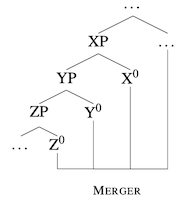| Friday April 5 | ||
| 1:30 – 1:45 | — Opening Remarks — | |
| 1:45 – 2:30 | David Embick | Stative passives: A window on some (smaller) syntactic structures |
| 2:30 – 3:15 | Jim Wood | Prepositions, nominalization and allosemy |
| 3:15 – 4:00 | Michelle Yuan | Participle-incorporation in Inuit: Consequences for incorporation and polysynthesis |
| 4:00 – 4:30 | — Coffee Break — | |
| 4:30 – 5:15 | Laura Kalin | Reconciling exceptional verb structure with V-to-C movement |
| 5:15 – 6:00 | Vrinda Chidambaram | Toward unifying the structures of synthetic and compositional superlatives |
| Saturday April 6 | ||
| 9:00 – 9:30 | — Breakfast — | |
| 9:30 – 10:15 | Norvin Richards | Constructing a theory mainly out of counterexamples: Contiguity Theory |
| 10:15 – 11:00 | Lauren Clemens | Preventing prosodic indeterminacy: a syntax-prosody mismatch in Rutooro’s relative clauses |
| 11:00 – 11:45 | Byron Ahn & Craig Sailor | The role of syntax in semantics-prosody misalignments |
| 11:45 – 1:30 | — Lunch — | |
| 1:30 – 2:15 | Gary Thoms | On some surprising contractions in varieties of Scots |
| 2:15 – 3:00 | Sandra Chung | On the Universality of NegP: A Māori Counterexample |
| 3:00 – 3:30 | — Coffee Break — | |
| 3:30 – 4:15 | Sandhya Sundaresan | When exceptions and rules co-exist: the case of indexical shift |
| 4:15 – 5:00 | Jane Grimshaw | Lexical unexceptionalism |
| 5:00 – 7:00 | — Reception — | |
Abstracts
Byron Ahn & Craig Sailor
“The role of syntax in semantics-prosody misalignments”
Prosodic marking of focus (p-Focus) and focus semantics (s-Focus) are known to be deeply related. In a stress-based language like English, the general maxim is understood to be that p-Focus must manifest within the domain of semantic focus (e.g., Halliday 1967, Rooth 1992, Selkirk 1995, Truckenbrodt 1995, Krifka 2004, Büring 2016). It is for this reason that “dogs CHASED cats”, with p-Focus on “chased”, cannot have an interpretation where alternatives to “dogs” are considered (i.e., with s-Focus on “dogs”). In this way, the location of p-Focus and s-Focus “align”. This sort of alignment data has been used to argue for the syntactic representation of focus (e.g., Jackendoff 1972, Selkirk 1984).
This talk explores a set of counterexamples to this maxim: cases of semantics-prosody focus misalignments, where p-Focus manifests outside the domain of s-Focus. An English example of this is “BOY can she sing beautifully”, where the s-Focus concerns degree of beauty but p-Focus is on “boy”. Misalignment cases like this can be found regularly and across languages.
We argue that these misalignments furnish a new argument in favor of syntactic representation of focus, and an architecture where semantics and phonology do not interface directly with one another. Misalignments can arise because phonology generates p-Focus, semantics generates s-Focus, and they do so independently of one another on the basis of syntactic Focus marking. In making this argument, we will see data from a range of languages, argue that there cannot be a single operation/constraint that determines the placement of p-Focus, and demonstrate that syntactic factors must be considered for p-Focus placement.
Vrinda Chidambaram
“Toward unifying the structures of synthetic and compositional superlatives”
A cross-linguistic study of the morphological composition of superlative degree adjectives yields remarkably limited variation; indeed, it has been observed that despite differences in the overt realization of superlative adjective formation, there are cross-typological uniformities that lend themselves to robust universal generalizations, perhaps most strikingly that superlatives are morphologically derived from comparative adjectives (Bobaljik 2012). In some languages, this is instantiated via morphological nesting of the comparative within the superlative, as in many Slavic languages.
Slovak
(1) Jozef je vyšší ako Peter.
Jozef is taller than Peter.
(2) Jozef je najvyšší (zo všetkých študentov).
Jozef is tallest (from all students)
Jozef is the tallest (among all the students).
This morphological embedding, though widespread, is not universal. The inevitable issue that arises with Bobaljik’s generalization, as with any such broad generalization, is how to reconcile universal principles with surface structural variation.
In this paper, I explore the syntax of one type of periphrastic superlative construction, namely the compositional superlative (as in (4)), which is transparently formed from a comparative adjective (as in (3)) but crucially also contains a universal quantifier as the comparand.
Tamil
(3) Raːmu Mohanai-viɖa oyaramaːnavan
Ramu.NOM.SG.MASC. Mohan.ACC.SG.MASC -than tall.MASC.SG. PRED.ADJ.
‘Ramu is taller than Mohan. (Chidambaram 2008)
(4) Raːmu ellaːraiyum -viɖa oyaramaːnavan
Ramu.NOM.SG.MASC. everyone.ACC. -than tall.MASC.SG. PRED.ADJ.
‘Ramu is the tallest.’ / lit. ‘Ramu is taller than everyone.’ (Chidambaram 2008)
I will show that compositional superlatives have the same essential structure as synthetic superlatives; that these are not, in fact, outliers or exceptions, but rather different manifestations of the same underlying syntax.
Sandy Chung
“On the Universality of NegP: A Māori Counterexample”
Since Laka’s and Zanuttini’s important work on the syntax of negation, it is often assumed that all languages have a functional head that realizes sentential negation (though languages can differ in just where this head is located on the clausal spine). Negation in the Polynesian language Māori provides a counterexample to this assumption. In this talk, I first rehearse the evidence assembled in earlier works that Māori negatives are not functional heads but rather stative verbs. I then suggest a way of accounting for this typologically unusual pattern that appeals to the syntax-semantics interface and the syntax-prosody interface.
Lauren Clemens
“Preventing prosodic indeterminacy: a syntax-prosody mismatch in Rutooro’s relative clauses”
While prosodic structure largely corresponds to syntactic structure, prosody is often found to be ‘flatter’ than syntax. Most research addressing apparent exceptions to syntax-prosody isomorphism utilizes one of two strategies: i) pursue sentence-level phonological well-formedness explanations, i.e. a phonological solution, or ii) propose an underlying syntax that matches the surface prosodic form, i.e. a syntactic solution. In this talk, I discuss a syntax-prosody mismatch in Rutooro, (first discussed in Bickmore and Clemens 2019), that defies both the strictly syntactic and prosodic explanations, arguing instead for a syntax-prosody interface solution. In Rutooro, a Bantu language of Uganda, phonological prominence is marked with a High tone (H) on the penultimate syllable of the phonological phrase (φ-phrase). Like many languages in the family, syntactic XPs reliably correspond to φ-phrases. However, reduced object RCs with overt subjects are a special case: the head of the reduced object RC bears an unexpected H tone, while the subject is all-Low despite the fact that it is a self-contained XP. I argue that the attested, non-isomorphic phrasing prevents an indeterminate prosodic structure from surfacing that, while predicted by the syntax and resolvable by the morphology, would result in the violation of the otherwise reliable correspondence between syntactic and prosodic constituents in the language. Thus, while the prosodic realization of one specific construction in the language is exceptional, this exception allows for greater regularity in the signaling of syntactic constituency via prosodic structure.
David Embick
“Stative passives: A window on some (smaller) syntactic structures”
[TBA]
Jane Grimshaw
“Lexical unexceptionalism”
Verbs vary greatly in the complements that they combine with: while DP, PP and CP complements are all possible with some verbs, individual verbs seem to choose from these options. Work which addresses this problem generally attaches to each verb a list of the combinations it allows, treating “lexical” properties as unsystematic.
Despite appearances, there is deep systematicity in complementation. This research focuses on effects which come to light when verbs combine with main clauses, instead of subordinate clauses, and supports the existence of structured skeletal representation of verb meanings in terms of core abstract predicates, such CAUSE, GO, and others in prior work. The skeleton for the abstract predicate SAY is a critical instance, as is HOLD. Each skeleton can be elaborated in various ways, resulting in differences in complement requirements. E.g. ask and assert differ in the Force of their complements.
The apparent wild misbehavior of many common verbs such as think and wonder can now be explained as the result of the association of a single verbal morpheme with more than one skeleton.
This proposal reduces “exceptionalism” by replacing stipulations encoded as selection of various kinds with general requirements of compatibility.
Laura Kalin
“Reconciling exceptional verb structure with V-to-C movement”
In this talk, I discuss an apparent Mirror Principle-violating verbal complex in the Neo-Aramaic language Turoyo, and the challenge that a non-canonical morphological structure poses for operations that require the verb to act as a constituent.
I will first show, using converging data from allomorphy, infixation, and and agreement restrictions, that the suffixes to the verb base in Turoyo appear in the opposite linear order from what is expected given their underlying syntactic hierarchy (Kalin 2018): the innermost suffix is the syntactically highest, and the outermost is the lowest. (This is reminiscent of the findings of Speas 1991 and Rice 2000 for Athapaskan languages.)
I will then turn to instances of what look like simple V-to-C movement, requiring this exceptional verbal complex to act as a constituent. To reconcile all of this data, I explore three possible approaches: (i) deriving the verb word as a phrasal constituent (à la Compton and Pittman 2010) which can then move, giving the appearance of head movement; (ii) deriving the verb word via long-distance head movement followed by post-syntactic amalgamation and chain reduction (à la Harizanov and Gribanova To appear); and (iii) deriving the verb word via merger in the post-syntax (à la Harley 2013) and re-inserting this into the syntax.
Norvin Richards
“Constructing a theory mainly out of counterexamples: Contiguity Theory”
[TBA]
Sandhya Sundaresan
“When exceptions and rules co-exist: the case of indexical shift”
In cases of indexical shift, the reference of the indexical pronoun (“I”, “you”, “here”, “now”) is evaluated, not against the utterance-context, but against the index, denoting the author, addressee, world, time, and location of the intensional event associated with an attitude verb. In English, for instance, the sentence “Maria said that I am sick”, can only be a statement about the sickness of whoever is uttering the sentence. But when the same sentence is expressed in Amharic or Zazaki, it can either have the English-like interpretation or mean that Maria said that she (Maria) is sick. I.e. “I” in Amharic/Zazaki (in contrast to “I” in English) can either be evaluated against the utterance-context, whose author is the utterance-speaker, or against the index of the matrix “say” verb, whose author is Maria. “Shift Together” (Anand & Nevins 2004, Deal 2018) is the generalization that shiftable indexicals in a local domain must all shift at the same time. Such a generalization forms the basis of the idea that indexical shift is achieved through replacing/overwriting the utterance-context with the attitudinal index. After all, if the original utterance-context is entirely “lost” in this manner, then all indexicals that can shift, must shift.
In this talk, I will show that while Shift Together does robustly hold in a number of languages, exceptions to Shift Together are attested as well. One piece of evidence for such an exception comes from so-called “monstrous agreement” patterns in Tamil: these involve a covert shifted 1st-person indexical (diagnosable by the overt 1st-person verbal agreement it triggers) and an overt unshifted 1st-person indexical within a single clause. Additional such exceptions will be adduced from embedded imperatives in Korean and Slovenian, and potentially also from Mutki Zazaki, Mus Kurdish, and Late Egyptian. Based on such counter-examples, I develop a novel syntax and semantics for indexical shift that derives the following. The syntactic and semantic mechanism of indexical shift ensures that, all else being equal, Shift Together must hold. But independent restrictions imposed by properties inherent to the indexicals themselves, in certain languages, can derive systematic exceptions. I show that this model makes the correct predictions in a language like Mishar Tatar, which simultaneously exhibits Shift Together and exceptions to it. The “monster” which effects indexical shift, in this system, is a dedicated complementizer along the functional spine of a clause, which intensionally quantifies over (different types of) context. An additional advantage of this proposal is that all intensional quantification, including quantification over worlds, is “monstrous” — a move that, in addition to providing a more uniform semantics for attitude reports, hopefully also demystifies indexical shift to some extent, by bringing it into the realm of the more familiar.
Gary Thoms
“On some surprising contractions in varieties of Scots”
Much work on the syntax-phonology interface has sought to address the distribution of contracted auxiliaries in English, and one of the main observations that this work has sought to address is the generalization that contraction is impossible in the immediate context of a gap created by movement or ellipsis (I don’t know where {*it’s / it is}). We document counterexamples to this restriction in varieties of Scots, all occurring in what we call a locative discovery expressions. We develop an analysis of this construction as an instance of mirative fronting, and using new data from the Scots Syntax Atlas we describe patterns of variation which provide clues as to the role of syntax in conditioning auxiliary contraction. Adapting the proposal in Wilder (1997), where contracted auxiliaries are prosodically incorporated into the following predicate, we provide an account in which the differences across dialects with respect to contraction are explained in terms of the availability of different abstract structures.
Jim Wood
“Prepositions, nominalization and allosemy”
In this talk, I examine three patterns of nominalization for Icelandic verbs that take PP complements, and argue that these patterns stem from locality constraints on root-allosemy. In the first pattern, the preposition must be prefixed to the derived nominal, and repeated in the complement PP (as in um-ræða um þetta ‘about-discussion about this’). In the second pattern, the preposition must be prefixed to the derived nominal, but is not repeated in the complement (as in við-gerð bílsins ‘with-repair the.car.GEN’). In the third pattern, the preposition is not prefixed to the verb, but only appears as the head of the PP complement (as in hugsun um þetta ‘thinking about this’). I show how these patterns reflect the ‘dual role’ of prepositions for verb meaning. On the one hand, prepositions may have semantics of their own, and on the other, they may condition special, in principle unpredictable meanings (allosemes) of the verbal root. Prefixing is necessary whenever the preposition conditions a special meaning on the root. The preposition will head the complement of the derived noun when it has its own, independent meaning contribution. Pattern I, then, involves prepositions that have their own meaning and condition special meaning on the root. Pattern 2 involves prepositions that only condition special meaning, and do not have any independent meaning of their own. Pattern 3 involves prepositions that condition no special meaning on the root, but make their own meaning contribution. I argue that these patterns are hard to understand if derived nominals are built on top of verb phrases, but make sense if derived nominals can be built as complex heads directly, by adjoining heads to each other. Adopting the segment/category distinction for adjunction, adjoining P to a derived noun can bring it closer to the root than it would be as a complement of that noun. Such adjunction creates a locality domain allowing P to condition special meaning on the root, making such prefixing obligatory for computing the intended meaning. I suggest that this may explain an apparent bracketing paradox that arises with the noun-noun analysis of synthetic compounds: idioms like blow the whistle / break the ice correspond to derived nominals like whistle-blower / ice-breaker but not their phrasal counterparts ??blowers of whistles / *breaker of ice. If synthetic compounds involve adjunction of the non-head to the head, then here too, this brings it close enough to the verb to compute the necessary special meaning.
Michelle Yuan
“Participle-incorporation in Inuit: Consequences for incorporation and polysynthesis”
Unlike noun incorporation (NI) cross-linguistically, noun incorporation in Inuit (Eskimo-Aleut) is obligatory with a closed class of verbs and otherwise impossible with all other verbs (Sadock 1980, Johns 2007). Typically, the direct object is incorporated, while modifiers (e.g. participial adjectives) are stranded and bear oblique case, (1a). This talk investigates an under-studied incorporation construction—a type of existential—in which the opposite properties seem to exceptionally hold. Here, it is the participle that undergoes incorporation, while the nominal is stranded, (1b).
| (1) | a. | aupak-tu-mik | nunasiuti-qaq-tuq |
| red-ptcp–obl | car-have-3s.S | ||
| ‘(S)he has a red car.’ | |||
| b. | nunasiuti-mik | [aupak-tu]-qaq-tuq | |
| car-obl | red-ptcp-have-3s.S | ||
| ‘There is a red car.’ | |||
I show that, despite surface appearances, (1a-b) involve the same structural relationship between the verb and the incorporated element. I argue that incorporation in Inuit is simply affixation, which is uniformly derived by a postsyntactic Merger operation applying between a head X0and the head Y0 of its complement YP. Polysynthetic word-formation involves repeated iterations of this process, (2).
(2) 
In (1a), the complement of the verb is the direct object. To explain (1b), however, I demonstrate that the nominal and participle are the subject and predicate of a pseudo-relative—a small clause whose predicate morphologically resembles a relative clause (e.g. Cinque 1995). Participle-incorporation arises because the verb -qaq ‘have’ takes this entire small clause as its complement. Time permitting, I show how this approach extends straightforwardly to an apparent paradox, noticed by Carrier (2016), concerning incorporation in low applicative constructions.












